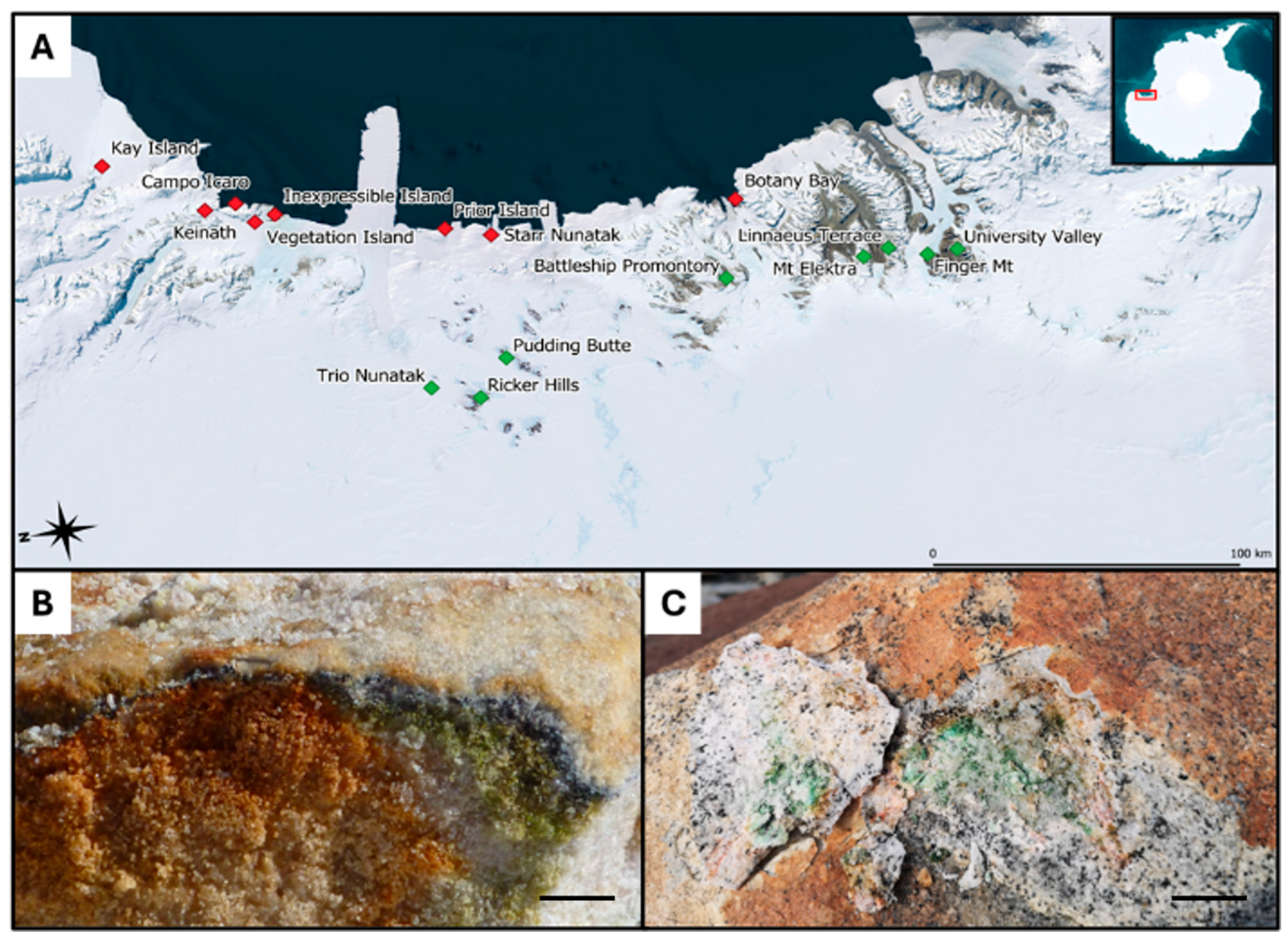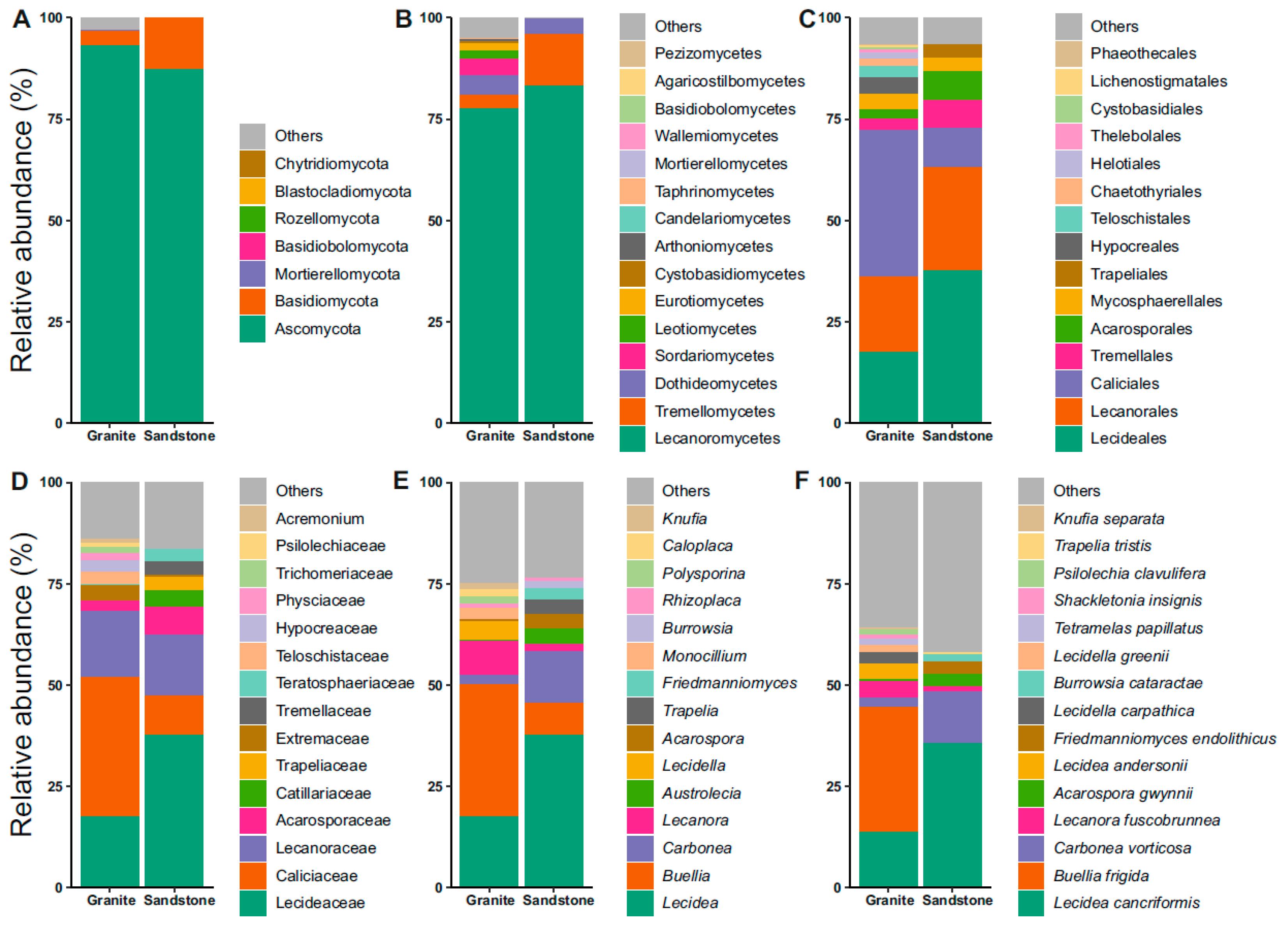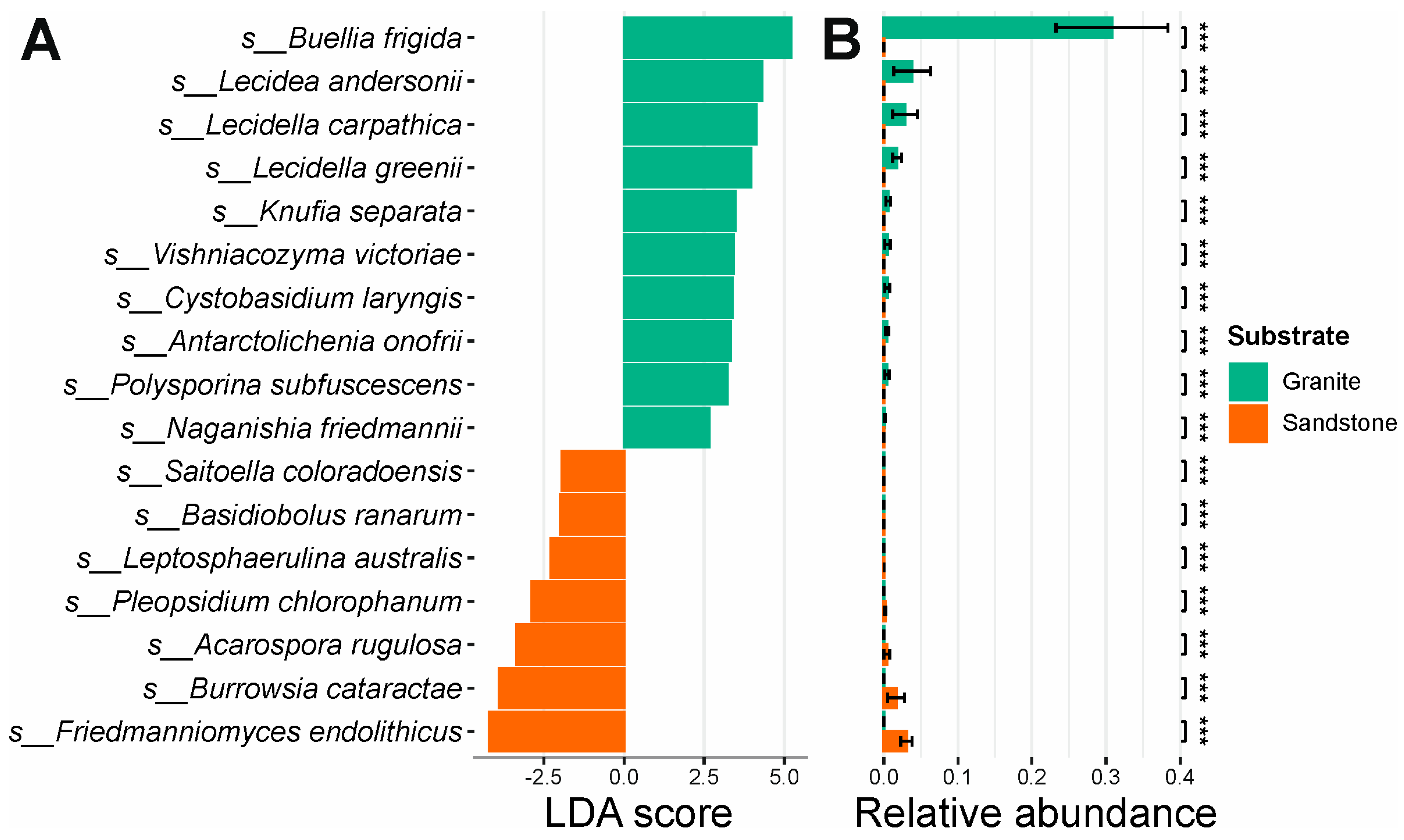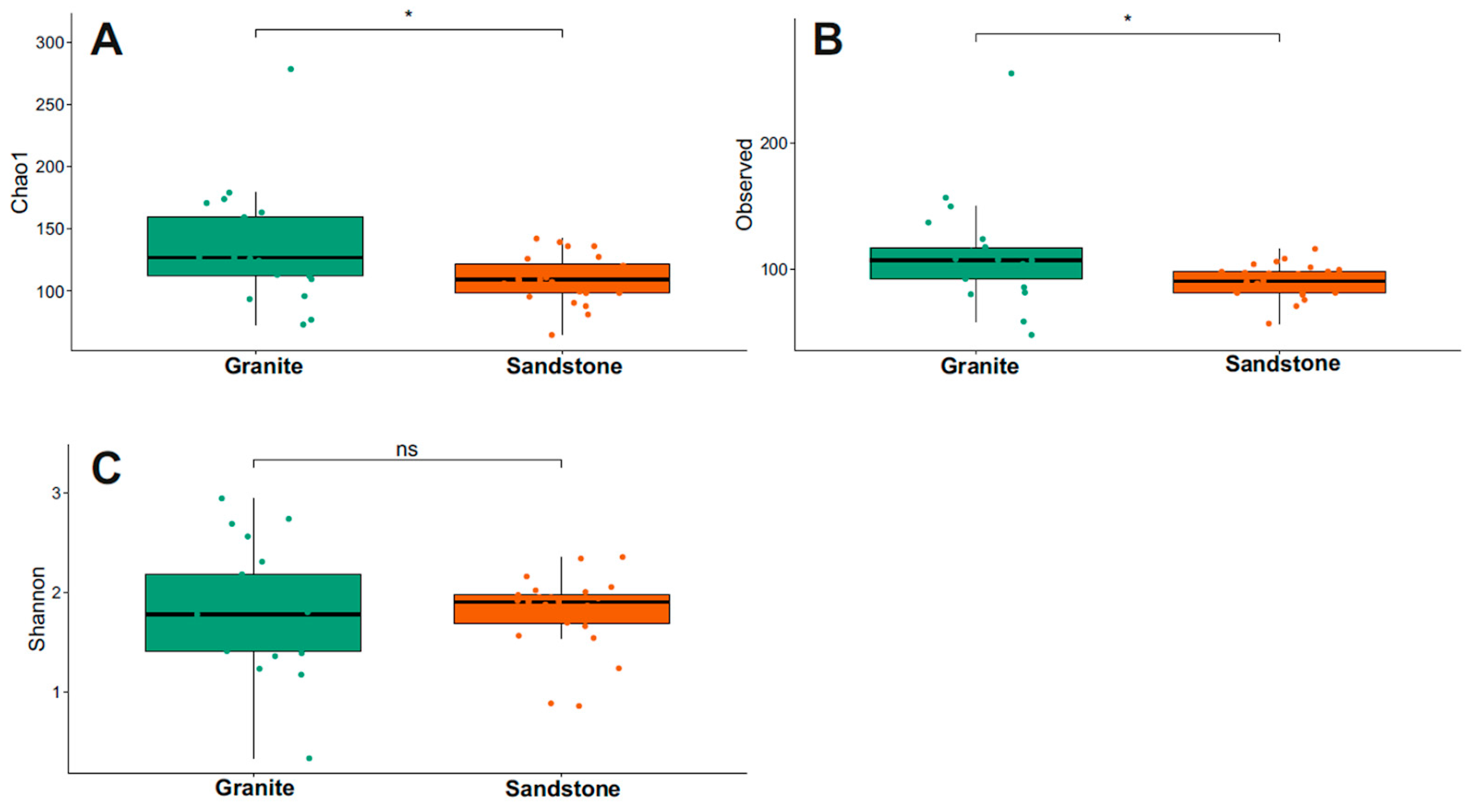Abundance and Diversity of Endolithic Fungal Assemblages in Granite and Sandstone from Victoria Land, Antarctica
Abstract
1. Introduction
2. Materials and Methods
2.1. Dataset Acquisition, Processing and Location
2.2. Bioinformatic Analysis
2.3. Statistical Analysis
3. Results
3.1. Fungal Taxonomy in Colonized Sandstone and Granite
3.2. Unique Species Divide the Fungal Communities Associated with Sandstone and Granite
3.3. Granite Hosts Higher Fungal Diversity than Sandstone
3.4. Influence of Rock Type and Geographical Location on Species Diversity
4. Discussion
5. Conclusions
Supplementary Materials
Author Contributions
Funding
Institutional Review Board Statement
Informed Consent Statement
Data Availability Statement
Acknowledgments
Conflicts of Interest
References
- Convey, P.; Peck, L.S. Antarctic environmental change and biological responses. Sci. Adv. 2019, 5, eaaz0888. [Google Scholar] [CrossRef] [PubMed]
- Leung, P.M.; Bay, S.K.; Meier, D.V.; Chiri, E.; Cowan, D.A.; Gillor, O.; Woebken, D.; Greening, C.; Stegen, J.C. Energetic basis of microbial growth and persistence in desert ecosystems. Msystems 2020, 5, 10–1128. [Google Scholar] [CrossRef]
- Cary, S.C.; McDonald, I.R.; Barrett, J.E.; Cowan, D.A. On the rocks: The microbiology of Antarctic Dry Valley soils. Nat. Rev. Microbiol. 2010, 8, 129–138. [Google Scholar] [CrossRef]
- Archer, S.D.J.; de los Ríos, A.; Lee, K.C.; Niederberger, T.S.; Cary, S.C.; Coyne, K.J.; Douglas, S.; Lacap-Bugler, D.C.; Pointing, S.B. Endolithic microbial diversity in sandstone and granite from the McMurdo Dry Valleys, Antarctica. Polar Biol. 2017, 40, 997–1006. [Google Scholar] [CrossRef]
- Onofri, S.; Selbmann, L.; Zucconi, L.; Pagano, S. Antarctic microfungi as models for exobiology. Planet. Space Sci. 2004, 52, 229–237. [Google Scholar] [CrossRef]
- Ruisi, S.; Barreca, D.; Selbmann, L.; Zucconi, L.; Onofri, S. Fungi in Antarctica. Rev. Environ. Sci. Bio/Technol. 2007, 6, 127–141. [Google Scholar] [CrossRef]
- Stivaletta, N.; Barbieri, R. Endolithic microorganisms from spring mound evaporite deposits (southern Tunisia). J. Arid Environ. 2009, 73, 33–39. [Google Scholar] [CrossRef]
- Wierzchos, J.; DiRuggiero, J.; Vítek, P.; Artieda, O.; Souza-Egipsy, V.; Škaloud, P.; Tisza, M.J.; Davila, A.F.; Vílchez, C.; Garbayo, I.; et al. Adaptation strategies of endolithic chlorophototrophs to survive the hyperarid and extreme solar radiation environment of the Atacama Desert. Front. Microbiol. 2015, 6, 934. [Google Scholar] [CrossRef]
- Selbmann, L.; Del Franco, C.; Stoppiello, G.A.; Ripa, C.; Belmonte Lopes, R.; Donati, C.; Franceschi, P.; Garcia-Aloy, M.; Cemmi, A.; Di Sarcina, I.; et al. The CRYPTOMARS project: A multi-omic approach for studying Antarctic crypto endolithic communities as Martian-analogue life-forms. Int. J. Astrobiol. 2025; in press. [Google Scholar] [CrossRef]
- Fanelli, G.; Coleine, C.; Gevi, F.; Onofri, S.; Selbmann, L.; Timperio, A.M. Metabolomics of dry versus reanimated antarctic lichen-dominated endolithic communities. Life 2021, 11, 96. [Google Scholar] [CrossRef]
- Amarelle, V.; Carrasco, V.; Fabiano, E. The hidden life of Antarctic rocks. In The Ecological Role of Micro-Organisms in the Antarctic Environment; Springer: Berlin/Heidelberg, Germany, 2019; pp. 221–237. [Google Scholar]
- Coleine, C.; Stajich, J.E.; de Los Ríos, A.; Selbmann, L. Beyond the extremes: Rocks as ultimate refuge for fungi in drylands. Mycologia 2021, 113, 108–133. [Google Scholar] [CrossRef]
- Friedmann, E.I. Endolithic microorganisms in the Antarctic cold desert. Science 1982, 215, 1045–1053. [Google Scholar] [CrossRef] [PubMed]
- Coleine, C.; Biagioli, F.; de Vera, J.P.; Onofri, S.; Selbmann, L. Endolithic microbial composition in Helliwell Hills, a newly investigated Mars-like area in Antarctica. Environ. Microbiol. 2021, 23, 4002–4016. [Google Scholar] [CrossRef] [PubMed]
- Choe, Y.H.; Kim, M.; Woo, J.; Lee, M.J.; Lee, J.I.; Lee, E.J.; Lee, Y.K. Comparing rock-inhabiting microbial communities in different rock types from a high arctic polar desert. FEMS Microbiol. Ecol. 2018, 94, fiy070. [Google Scholar] [CrossRef]
- Larsen, S.; Coleine, C.; Albanese, D.; Stegen, J.C.; Selbmann, L.; Donati, C. Geology and elevation shape bacterial assembly in Antarctic endolithic communities. Sci. Total Environ. 2024, 907, 168050. [Google Scholar] [CrossRef]
- Stoppiello, G.A.; Muggia, L.; De Carolis, R.; Coleine, C.; Selbmann, L. Ecological niche drives fungal and bacterial diversity in endolithic and epilithic communities inhabiting granites in Victoria Land, Antarctica. Polar Biol. 2025, 48, 16. [Google Scholar] [CrossRef]
- Biagioli, F.; Coleine, C.; Buzzini, P.; Turchetti, B.; Sannino, C.; Selbmann, L. Positive fungal interactions are key drivers in Antarctic endolithic microcosms at the boundaries for life sustainability. FEMS Microbiol. Ecol. 2023, 99, fiad045. [Google Scholar] [CrossRef]
- Bradshaw, M.A. Paleoenvironmental interpretations and systematics of Devonian trace fossils from the Taylor Group (lower Beacon Supergroup), Antarctica. N. Z. J. Geol. Geophys. 1981, 24, 615–652. [Google Scholar] [CrossRef]
- Casnedi, R.; Di Giulio, A. Sedimentology of the section Peak Formation (jurassic), northern victoria land, Antarctica. In Fluvial Sedimentology VI; The International Association of Sedimentologists: Oxford, UK, 1999; pp. 435–449. [Google Scholar]
- Davis, N.M.; Proctor, D.M.; Holmes, S.P.; Relman, D.A.; Callahan, B.J. Simple statistical identification and removal of contaminant sequences in marker-gene and metagenomics data. Microbiome 2018, 6, 226. [Google Scholar] [CrossRef]
- Palmer, J.M.; Jusino, M.A.; Banik, M.T.; Lindner, D.L. Non-biological synthetic spike-in controls and the AMPtk software pipeline improve mycobiome data. PeerJ 2018, 6, e4925. [Google Scholar] [CrossRef]
- Edgar, R.C. Search and clustering orders of magnitude faster than BLAST. Bioinformatics 2010, 26, 2460–2461. [Google Scholar] [CrossRef]
- Rognes, T.; Flouri, T.; Nichols, B.; Quince, C.; Mahé, F. VSEARCH: A versatile open source tool for metagenomics. PeerJ 2016, 4, e2584. [Google Scholar] [CrossRef] [PubMed]
- Cole, J.R.; Wang, Q.; Fish, J.A.; Chai, B.; McGarrell, D.M.; Sun, Y.; Brown, C.T.; Porras-Alfaro, A.; Kuske, C.R.; Tiedje, J.M. Ribosomal Database Project: Data and tools for high throughput rRNA analysis. Nucleic Acids Res. 2014, 42, D633–D642. [Google Scholar] [CrossRef]
- Abarenkov, K.; Zirk, A.; Piirmann, T.; Pöhönen, R.; Ivanov, F.; Nilsson, R.H.; Kõljalg, U. UNITE QIIME release for Fungi. (No Title).
- Liu, C.; Cui, Y.; Li, X.; Yao, M. microeco: An R package for data mining in microbial community ecology. FEMS Microbiol. Ecol. 2021, 97, fiaa255. [Google Scholar] [CrossRef] [PubMed]
- McMurdie, P.J.; Holmes, S. phyloseq: An R package for reproducible interactive analysis and graphics of microbiome census data. PLoS ONE 2013, 8, e61217. [Google Scholar] [CrossRef]
- Kruskal, W.H.; Wallis, W.A. Use of ranks in one-criterion variance analysis. J. Am. Stat. Assoc. 1952, 47, 583–621. [Google Scholar] [CrossRef]
- Wilcoxon, F. Individual comparisons by ranking methods. Biom. Bull. 1945, 1, 80–83. [Google Scholar] [CrossRef]
- Segata, N.; Izard, J.; Waldron, L.; Gevers, D.; Miropolsky, L.; Garrett, W.S.; Huttenhower, C. Metagenomic biomarker discovery and explanation. Genome Biol. 2011, 12, R60. [Google Scholar] [CrossRef] [PubMed]
- Selbmann, L.; De Hoog, G.S.; Mazzaglia, A.; Friedmann, E.I.; Onofri, S. Fungi at the edge of life: Cryptoendolithic black fungi from Antarctic desert. Study Mycol. 2005, 51, 1–32. [Google Scholar]
- Selbmann, L.; de Hoog, G.S.; Zucconi, L.; Isola, D.; Ruisi, S.; Gerrits van den Ende, A.H.G.; Ruibal, C.; De Leo, F.; Urzì, C.; Onofri, S. Drought meets acid: Three new genera in a dothidealean clade of extremotolerant fungi. Stud. Mycol. 2008, 61, 1–20. [Google Scholar] [CrossRef]
- Egidi, E.; de Hoog, G.S.; Isola, D.; Onofri, S.; Quaedvlieg, W.; de Vries, M.; Verkley, G.J.M.; Stielow, J.B.; Zucconi, L.; Selbmann, L. Phylogeny and taxonomy of meristematic rock-inhabiting black fungi in the Dothideomycetes based on multi-locus phylogenies. Fungal Divers. 2014, 65, 127–165. [Google Scholar] [CrossRef]
- Coleine, C.; Stajich, J.E.; Zucconi, L.; Onofri, S.; Pombubpa, N.; Egidi, E.; Franks, A.; Buzzini, P.; Selbmann, L. Antarctic cryptoendolithic fungal communities are highly adapted and dominated by Lecanoromycetes and Dothideomycetes. Front. Microbiol. 2018, 9, 1392. [Google Scholar] [CrossRef] [PubMed]
- Canini, F.; Borruso, L.; Newsham, K.K.; D’Alò, F.; D’Acqui, L.P.; Zucconi, L. Wide divergence of fungal communities inhabiting rocks and soils in a hyper-arid Antarctic desert. Environ. Microbiol. 2023, 25, 3671–3682. [Google Scholar] [CrossRef] [PubMed]
- Kappen, L.; Schroeter, B.; Green, T.G.A.; Seppelt, R.D. Microclimatic conditions, meltwater moistening, and the distributional pattern of Buellia frigida on rock in a southern continental Antarctic habitat. Polar Biol. 1998, 19, 101–106. [Google Scholar] [CrossRef]
- Jones, T.C.; Green, T.G.; Hogg, I.D.; Wilkins, R.J. Isolation and characterization of microsatellites in the lichen Buellia frigida (Physciaceae), an Antarctic endemic. Am. J. Bot. 2012, 99, e131–e133. [Google Scholar] [CrossRef][Green Version]
- De los Rios, A.; Sancho, L.G.; Grube, M.; Wierzchos, J.; Ascaso, C. Endolithic growth of two Lecidea lichens in granite from continental Antarctica detected by molecular and microscopy techniques. New Phytol. 2005, 165, 181–190. [Google Scholar] [CrossRef]
- Selbmann, L.; Zucconi, L.; Onofri, S.; Cecchini, C.; Isola, D.; Turchetti, B.; Buzzini, P. Taxonomic and phenotypic characterization of yeasts isolated from worldwide cold rock-associated habitats. Fungal Biol. 2014, 118, 61–71. [Google Scholar] [CrossRef] [PubMed]
- Selbmann, L.; Onofri, S.; Coleine, C.; Buzzini, P.; Canini, F.; Zucconi, L. Effect of environmental parameters on biodiversity of the fungal component in lithic Antarctic communities. Extremophiles 2017, 21, 1069–1080. [Google Scholar] [CrossRef]
- Turchetti, B.; Selbmann, L.; Gunde-Cimerman, N.; Buzzini, P.; Sampaio, J.P.; Zalar, P. Cystobasidium alpinum sp. nov. and Rhodosporidiobolus oreadorum sp. nov. from European cold environments and Arctic region. Life 2018, 8, 9. [Google Scholar] [CrossRef]
- Tsuji, M.; Tsujimoto, M.; Imura, S. Cystobasidium tubakii and Cystobasidium ongulense, new basidiomycetous yeast species isolated from East Ongul Island, East Antarctica. Mycoscience 2016, 58, 103–110. [Google Scholar] [CrossRef]
- Stoppiello, G.A.; Coleine, C.; Moeller, R.; Ripa, C.; Billi, D.; Selbmann, L. Seasonality Is the Main Determinant of Microbial Diversity Associated to Snow/Ice around Concordia Station on the Antarctic Polar Plateau. Biology 2023, 12, 1193. [Google Scholar] [CrossRef]
- Sannino, C.; Borruso, L.; Mezzasoma, A.; Turchetti, B.; Ponti, S.; Buzzini, P.; Mimmo, T.; Guglielmin, M. The Unusual dominance of the yeast genus Glaciozyma in the deeper layer in an Antarctic Permafrost Core (Adélie Cove, Northern Victoria Land) is driven by elemental composition. J. Fungi 2023, 9, 435. [Google Scholar] [CrossRef] [PubMed]
- Tsuji, M.; Kudoh, S. Soil Yeasts in the Vicinity of Syowa Station, East Antarctica: Their diversity and extracellular enzymes, cold adaptation strategies, and secondary metabolites. Sustainability 2020, 12, 4518. [Google Scholar] [CrossRef]
- Muggia, L.; Coleine, C.; De Carolis, R.; Cometto, A.; Selbmann, L. Antarctolichenia onofrii gen. nov. sp. nov. from Antarctic endolithic communities untangles the evolution of rock-inhabiting and lichenized fungi in Arthoniomycetes. J. Fungi 2021, 7, 935. [Google Scholar] [CrossRef] [PubMed]
- Selbmann, L.; Stoppiello, G.A.; Onofri, S.; Stajich, J.E.; Coleine, C. Culture-dependent and amplicon sequencing approaches reveal diversity and distribution of black fungi in Antarctic cryptoendolithic communities. J. Fungi 2021, 7, 213. [Google Scholar] [CrossRef]
- Fryday, A.M.; Medeiros, I.D.; Siebert, S.J.; Pope, N.; Rajakaruna, N. Burrowsia, a new genus of lichenized fungi (Caliciaceae), plus the new species B. cataractae and Scoliciosporum fabisporum, from Mpumalanga, South Africa. S. Afr. J. Bot. 2020, 132, 471–481. [Google Scholar] [CrossRef]
- Coleine, C.; Delgado-Baquerizo, M.; Zerboni, A.; Turchetti, B.; Buzzini, P.; Franceschi, P.; Selbmann, L. Rock traits drive complex microbial communities at the edge of life. Astrobiology 2023, 23, 395–406. [Google Scholar] [CrossRef]





| Locality | Coordinates | Endolithic Communities (Granite) | Endolithic Communities (Sandstone) |
|---|---|---|---|
| Botany Bay | −77.005433, 162.534183 | 3 | 0 |
| Inexpressible Island | −74.89265, 163.7377 | 3 | 0 |
| Vegetation Island | −74.7874, 163.641933 | 3 | 0 |
| Prior Island | −75.691667, 162.878611 | 3 | 0 |
| Kay Island | −74.070583, 165.316533 | 2 | 0 |
| Starr Nunatak | −75.898767, 162.594683 | 3 | 0 |
| Mt Keinath | −74.550117, 164.053567 | 1 | 0 |
| Campo Icaro | −74.709367, 164.095967 | 3 | 0 |
| Battleship Promontory | −76.9011, 160.9102 | 0 | 3 |
| Finger Mt | −77.7503, 160.7457 | 0 | 3 |
| Linnaeus Terrace | −77.5978, 161.0067 | 0 | 3 |
| Mt Elektra | −77.4911, 160.9046 | 0 | 3 |
| Pudding Butte | −75.8584, 159.9738 | 0 | 3 |
| Ricker Hills | −75.7041, 159.2276 | 0 | 3 |
| Trio Nunatak | −75.4824, 159.5912 | 0 | 3 |
| University Valley | −77.8726, 160.7553 | 0 | 3 |
Disclaimer/Publisher’s Note: The statements, opinions and data contained in all publications are solely those of the individual author(s) and contributor(s) and not of MDPI and/or the editor(s). MDPI and/or the editor(s) disclaim responsibility for any injury to people or property resulting from any ideas, methods, instructions or products referred to in the content. |
© 2025 by the authors. Licensee MDPI, Basel, Switzerland. This article is an open access article distributed under the terms and conditions of the Creative Commons Attribution (CC BY) license (https://creativecommons.org/licenses/by/4.0/).
Share and Cite
Stoppiello, G.A.; Del Franco, C.; Muggia, L.; Ripa, C.; Selbmann, L. Abundance and Diversity of Endolithic Fungal Assemblages in Granite and Sandstone from Victoria Land, Antarctica. Life 2025, 15, 1028. https://doi.org/10.3390/life15071028
Stoppiello GA, Del Franco C, Muggia L, Ripa C, Selbmann L. Abundance and Diversity of Endolithic Fungal Assemblages in Granite and Sandstone from Victoria Land, Antarctica. Life. 2025; 15(7):1028. https://doi.org/10.3390/life15071028
Chicago/Turabian StyleStoppiello, Gerardo A., Carmen Del Franco, Lucia Muggia, Caterina Ripa, and Laura Selbmann. 2025. "Abundance and Diversity of Endolithic Fungal Assemblages in Granite and Sandstone from Victoria Land, Antarctica" Life 15, no. 7: 1028. https://doi.org/10.3390/life15071028
APA StyleStoppiello, G. A., Del Franco, C., Muggia, L., Ripa, C., & Selbmann, L. (2025). Abundance and Diversity of Endolithic Fungal Assemblages in Granite and Sandstone from Victoria Land, Antarctica. Life, 15(7), 1028. https://doi.org/10.3390/life15071028








